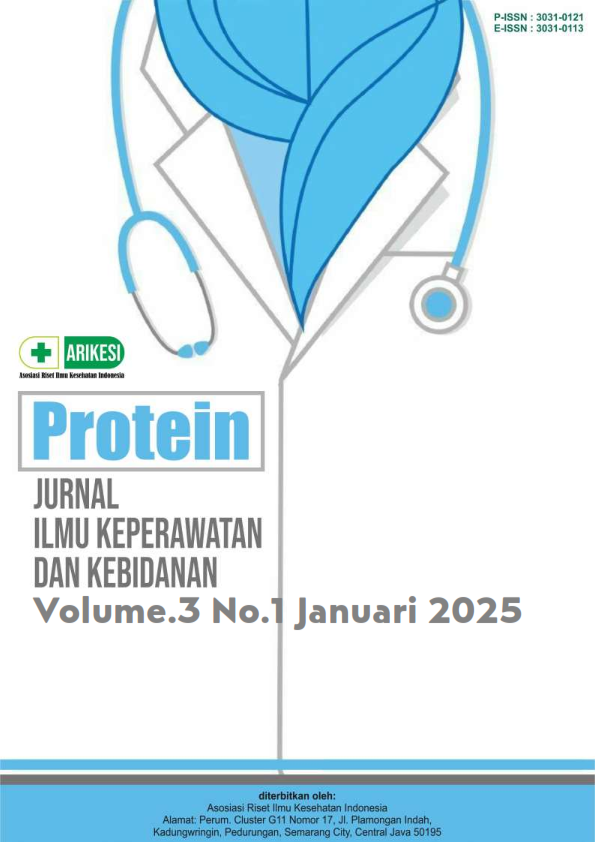Pengaruh Penggunaan Kompres Hangat terhadap Intesitas Nyeri Persalinan Kala I Fase Aktif di PMB Nursehan Dahliana Birayang Banjarmasin Kalimantan Selatan
DOI:
https://doi.org/10.61132/protein.v3i1.1102Keywords:
Warm Compresses, Labor Pain, Phase I Active PhaseAbstract
Childbirth causes pain due to shortening of the uterine muscles. Normal childbirth occurs because of pain, which is an important part of labor. During labor, pain can influence uterine contractions through the secretion of catecholamines and cortisol. It improves the function of the sympathetic nervous system, changing blood pressure, heart rate, breathing, and length of labor. The aim of this research is to find out how warm compresses impact how severe the pain of labor during the first active phase is. This research design is pre-experimental with a one group pre test and post test design. The population in this study were all mothers giving birth at BPM Nursehan Dahliana Birayang (Hulu Sungai Tengah Regency, South Kalimantan Province), using an accidental sampling technique and a sample size of 30 respondents was obtained. A warm compress is placed on the lower abdomen using a hot bladder. Data analysis used the Paired T - test. Based on the research results obtained, the average pain score before treatment was 8.13 and the average pain score after treatment was 4.66. The results of statistical analysis of tests of differences in pain intensity before and after treatment showed significant differences (p=0.000; 95% CI -3.900-(-3.031). The conclusion of this study is: warm compresses can reduce the intensity of labor pain in the active phase of the first stage. Warm compresses can be used as a way to reduce the intensity of labor pain.
Downloads
References
Afritayeni, A. (2017). Hubungan usia, jumlah persalinan, dan pendamping persalinan dengan tingkat nyeri persalinan kala I. Jurnal Endurance: Kajian Ilmiah Problema Kesehatan, 2(2), 178–185.
Gayeski, M. E., Brüggemann, O. M., Monticelli, M., & dos Santos, E. K. A. (2015). Penerapan metode nonfarmakologis untuk meredakan nyeri selama persalinan: Sudut pandang ibu primipara. Pain Management Nursing, 16(3), 273–284. https://doi.org/10.1016/j.pmn.2014.08.006
Irawati, Muliani, & Gusman Arsyad. (2019). Efek pemberian kompres hangat terhadap penurunan tingkat nyeri persalinan pada ibu inpartu kala I fase aktif. Jurnal Bidan Cerdas, 2(1), 46–53. Diakses dari http://jurnal.poltekkespalu.ac.id/index.php/JBC/Vol.2No.1
Jones, L., Othman, M., Dowswell, T., Alfirevic, Z., Gates, S., Newburn, M., & Neilson, J. P. (2012). Manajemen nyeri bagi wanita dalam persalinan: Tinjauan sistematis. Cochrane Database of Systematic Reviews, (3), CD009234. https://doi.org/10.1002/14651858.CD009234.pub2
Judha, M., & Sudarti, F. A. (2012). Teori pengukuran nyeri dan nyeri persalinan. Yogyakarta: Nuha Medika.
Klomp, T., de Jonge, A., Hutton, E. K., & Lagro-Janssen, A. L. M. (2013). Preferensi dan penggunaan metode pengurangan nyeri oleh wanita Belanda yang berada dalam perawatan bidan saat awal persalinan. BMC Pregnancy and Childbirth, 13(1), 230. https://doi.org/10.1186/1471-2393-13-230
Lowdermilk, D. L., Perry, S. E., Cashion, M. C., Alden, K. R., & Olshansky, E. (2012). Perawatan maternitas dan kesehatan wanita. St. Louis: Mosby Inc.
Manurung, S., Nuraeni, A., Lestari, T. R., Soleha, I., Suryati, S., Nurhaeni, H., & Rahmawaty, E. (2013). Efek kompres hangat terhadap perubahan tingkat nyeri persalinan pada ibu primigravida. Jurnal Health Quality, 4(1–8).
Melzack, R., & Wall, P. D. (1965). Mekanisme nyeri: Teori baru. Science, 150(3699), 971–979. https://doi.org/10.1126/science.150.3699.971
Potter, P. A., Perry, A. G., Stockert, P., & Hall, A. (2016). Fundamentals of nursing (E-Book). St. Louis: Elsevier Health Sciences.
Prata, N., Hamza, S., Bell, S., Karasek, D., Vahidnia, F., & Holston, M. (2011). Ketidakmampuan dalam memprediksi perdarahan postpartum: Wawasan dari data intervensi di Mesir. BMC Pregnancy and Childbirth, 11(1), 97. https://doi.org/10.1186/1471-2393-11-97
Price, & Wilson. (2006). Patofisiologi: Konsep klinis dalam proses penyakit. Jakarta: EGC - Penerbit Buku Kedokteran.
Prisusanti, R. D., Kanan, M., Badawi, B., Elis, A., Syahrir, M., Yusuf, N. N., & Purnama, Y. (2022). Keterampilan klinik dalam praktik kebidanan. Yayasan Penerbit Muhammad Zaini.
Prisusanti, R. D., ST, S., Dewi, C., KM, S., Kiriwenno, E., & Prastiwi, R. S. (2022). Kesehatan reproduksi dan kesehatan wanita.
Ye, H., Jiang, Y., & Ruan, Z. (2011). Hubungan antara faktor-faktor yang mempengaruhi nyeri persalinan dengan hasil persalinan. Zhonghua Fu Chan Ke Za Zhi, 46(10), 753–757. Diakses dari http://www.ncbi.nlm.nih.gov/pubmed/22321349
Zwelling, E., Johnson, K., & Allen, J. (2006). Cara mengimplementasikan terapi komplementer untuk wanita dalam persalinan. MCN, The American Journal of Maternal/Child Nursing, 31(6), 364–370. https://doi.org/10.1097/00005721-200611000-00006
Downloads
Published
How to Cite
Issue
Section
License
Copyright (c) 2024 Protein : Jurnal Ilmu Keperawatan dan Kebidanan.

This work is licensed under a Creative Commons Attribution-ShareAlike 4.0 International License.





